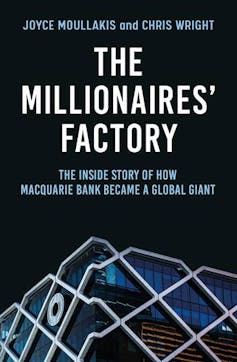The Millionaires' Factory lays bare the good and bad about Australia's millionaire manufacturer – Macquarie bank
- Written by The Conversation
 Allen & Unwin
The Millionaires’ Factory, subtitled “the inside story of how Macquarie Bank became a global giant” by financial journalists Joyce Moullakis and Chris Wright is an impressive, informative book that I enjoyed reading.
As well as providing insights into the Australian financial giant’s evolution, organisation, scope and success, it says a lot about Australia’s financial history.
The large number of Macquarie alumni (the book suggests around 100,000) and current staff (more than 18,000 globally in 2022) will provide a ready market.
But for others, despite the many interesting character sketches and well-written “travelogue” through Macquarie’s exploits, the book may be somewhat heavy going – for one main reason.
Macquarie is a mammoth organisation that has been involved in a huge number of complex financial activities across the international stage.
Macquarie’s 2022 annual report says it operates across 33 markets in
Outlines of key transactions alone, necessarily, form a large part of the book.
Unfortunately, most need virtually an entire book each to explain and, in any event, require a high level of financial expertise to properly understand.
Those who are not finance experts can skip over the specific deals and will still find much value in (at least) two parts of the book.
One is the information on the management and governance of the organisation, including the adaptability of its divisional structure to opportunities and challenges.
Macquarie has consistently shown a willingness to expand into new (generally “adjacent”) activities suggested by staff (rather than from the top) under a strict risk-control framework.
A second (related) element is its emphasis on the quality of its staff and its dependence on its staff to investigate, generate and develop new activities.
Turning staff into millionaires
The remuneration arrangements bring the promise of rich personal rewards if successful, while failure in a new activity that has received the go-ahead under strict risk controls is not a career-limiting outcome.
Some readers may find strange the continued recitation of names and characteristics of key Macquarie personnel – but it is the people involved who have made Macquarie what it is today. As the saying goes, in financial institutions the main assets walk out the door every night (or early morning in many cases).
One thing the book does not do is provide any tables or graphs showing the enormous growth of Macquarie since its creation out of Hill Samuel in 1985, its integral role in Australia’s financial system and its successful overseas expansion.
Of course, given the scope of Macquarie’s activities, relevant metrics for comparison purposes are not easy to identify. For example, Macquarie Bank (the “commercial banking” part of the group) is small compared to the four major banks, with resident deposits about one-third of the smallest of the big four, ANZ.
The Macquarie Group overall has about half the number of employees of ANZ, but its overall personnel expenses in 2022 were around 15% higher than the ANZ (reflecting the words “millionaires’ factory” used in the book’s title).
Pushing boundaries
The authors hint at, but do not address, several questions posed by Macquarie Group’s critics.
First, to what extent have Macquarie’s profits come from pushing the boundaries of tax arbitrage (such as moving profits from high-tax locations to low-tax locations and moving losses in the other direction), such that its resulting profit isn’t a reward for adding social value but is instead generated at the expense of taxpayers?
There are always loopholes in tax law due to imperfect drafting, or grey areas that fall between what is clearly within or outside of the law. The opportunity to exploit such loopholes is greater when several jurisdictions are involved, and the book refers to several, such as the “cum-ex” dividend arbitrage. There are others.
Read more:
The robbery of the century: the cum-ex trading scandal
The profit motive underpinning Macquarie and its remuneration structure naturally lead towards attempts to exploit such opportunities even if the private gains are purely at the expense of government tax revenue and not involving any (or much) creation of social value.
The authors quote former Treasurer Peter Costello saying “they engineered tax breaks to within an inch of their lives”, which often led to changes to tax laws to prevent such activities. How much this is ethical behaviour is a matter of opinion!
Heavily charging customers
The second question is: in constructing value-adding deals with clients and customers, how much of the net benefit has accrued to Macquarie, and how much to its customers?
As well as the nickname of “Millionaires’ Factory”, Macquarie has also been referred to as the “fee factory”.
For example, in its now-abandoned infrastructure trust structures, various parts of Macquarie would obtain fees: when purchasing assets for the trust (and “clipping the ticket” via a profit on the sale price into the trust), fees from managing the trust, commissions from selling units in the trust to investors, etc.
Macquarie’s position as an innovative creator of financial products and structures has often given it a first-mover advantage, such that with no competing supplier, Macquarie has been able to extract a major part of the value created.
Obviously, some value for the client needs to be provided, and concerns that a perceived unfair distribution of benefits would make it hard to repeat the exercise limit the amount of value extraction possible. But what is “fair” is a matter of opinion!
Exploiting the poorly informed
The third question is: to what extent did Macquarie benefit from exploiting poorly informed (wholesale and retail) consumers and users of its financial products – as the Hayne Royal Commission found to be the case for the four major banks and others?
Macquarie escaped from the Royal Commission with its image barely tarnished compared to the big four. One reason was that its then-chief executive, Nicholas Moore, was able to point to the remediation activities it had put in place prior to the commission once it had recognised the problems.
Allen & Unwin
The Millionaires’ Factory, subtitled “the inside story of how Macquarie Bank became a global giant” by financial journalists Joyce Moullakis and Chris Wright is an impressive, informative book that I enjoyed reading.
As well as providing insights into the Australian financial giant’s evolution, organisation, scope and success, it says a lot about Australia’s financial history.
The large number of Macquarie alumni (the book suggests around 100,000) and current staff (more than 18,000 globally in 2022) will provide a ready market.
But for others, despite the many interesting character sketches and well-written “travelogue” through Macquarie’s exploits, the book may be somewhat heavy going – for one main reason.
Macquarie is a mammoth organisation that has been involved in a huge number of complex financial activities across the international stage.
Macquarie’s 2022 annual report says it operates across 33 markets in
Outlines of key transactions alone, necessarily, form a large part of the book.
Unfortunately, most need virtually an entire book each to explain and, in any event, require a high level of financial expertise to properly understand.
Those who are not finance experts can skip over the specific deals and will still find much value in (at least) two parts of the book.
One is the information on the management and governance of the organisation, including the adaptability of its divisional structure to opportunities and challenges.
Macquarie has consistently shown a willingness to expand into new (generally “adjacent”) activities suggested by staff (rather than from the top) under a strict risk-control framework.
A second (related) element is its emphasis on the quality of its staff and its dependence on its staff to investigate, generate and develop new activities.
Turning staff into millionaires
The remuneration arrangements bring the promise of rich personal rewards if successful, while failure in a new activity that has received the go-ahead under strict risk controls is not a career-limiting outcome.
Some readers may find strange the continued recitation of names and characteristics of key Macquarie personnel – but it is the people involved who have made Macquarie what it is today. As the saying goes, in financial institutions the main assets walk out the door every night (or early morning in many cases).
One thing the book does not do is provide any tables or graphs showing the enormous growth of Macquarie since its creation out of Hill Samuel in 1985, its integral role in Australia’s financial system and its successful overseas expansion.
Of course, given the scope of Macquarie’s activities, relevant metrics for comparison purposes are not easy to identify. For example, Macquarie Bank (the “commercial banking” part of the group) is small compared to the four major banks, with resident deposits about one-third of the smallest of the big four, ANZ.
The Macquarie Group overall has about half the number of employees of ANZ, but its overall personnel expenses in 2022 were around 15% higher than the ANZ (reflecting the words “millionaires’ factory” used in the book’s title).
Pushing boundaries
The authors hint at, but do not address, several questions posed by Macquarie Group’s critics.
First, to what extent have Macquarie’s profits come from pushing the boundaries of tax arbitrage (such as moving profits from high-tax locations to low-tax locations and moving losses in the other direction), such that its resulting profit isn’t a reward for adding social value but is instead generated at the expense of taxpayers?
There are always loopholes in tax law due to imperfect drafting, or grey areas that fall between what is clearly within or outside of the law. The opportunity to exploit such loopholes is greater when several jurisdictions are involved, and the book refers to several, such as the “cum-ex” dividend arbitrage. There are others.
Read more:
The robbery of the century: the cum-ex trading scandal
The profit motive underpinning Macquarie and its remuneration structure naturally lead towards attempts to exploit such opportunities even if the private gains are purely at the expense of government tax revenue and not involving any (or much) creation of social value.
The authors quote former Treasurer Peter Costello saying “they engineered tax breaks to within an inch of their lives”, which often led to changes to tax laws to prevent such activities. How much this is ethical behaviour is a matter of opinion!
Heavily charging customers
The second question is: in constructing value-adding deals with clients and customers, how much of the net benefit has accrued to Macquarie, and how much to its customers?
As well as the nickname of “Millionaires’ Factory”, Macquarie has also been referred to as the “fee factory”.
For example, in its now-abandoned infrastructure trust structures, various parts of Macquarie would obtain fees: when purchasing assets for the trust (and “clipping the ticket” via a profit on the sale price into the trust), fees from managing the trust, commissions from selling units in the trust to investors, etc.
Macquarie’s position as an innovative creator of financial products and structures has often given it a first-mover advantage, such that with no competing supplier, Macquarie has been able to extract a major part of the value created.
Obviously, some value for the client needs to be provided, and concerns that a perceived unfair distribution of benefits would make it hard to repeat the exercise limit the amount of value extraction possible. But what is “fair” is a matter of opinion!
Exploiting the poorly informed
The third question is: to what extent did Macquarie benefit from exploiting poorly informed (wholesale and retail) consumers and users of its financial products – as the Hayne Royal Commission found to be the case for the four major banks and others?
Macquarie escaped from the Royal Commission with its image barely tarnished compared to the big four. One reason was that its then-chief executive, Nicholas Moore, was able to point to the remediation activities it had put in place prior to the commission once it had recognised the problems.














